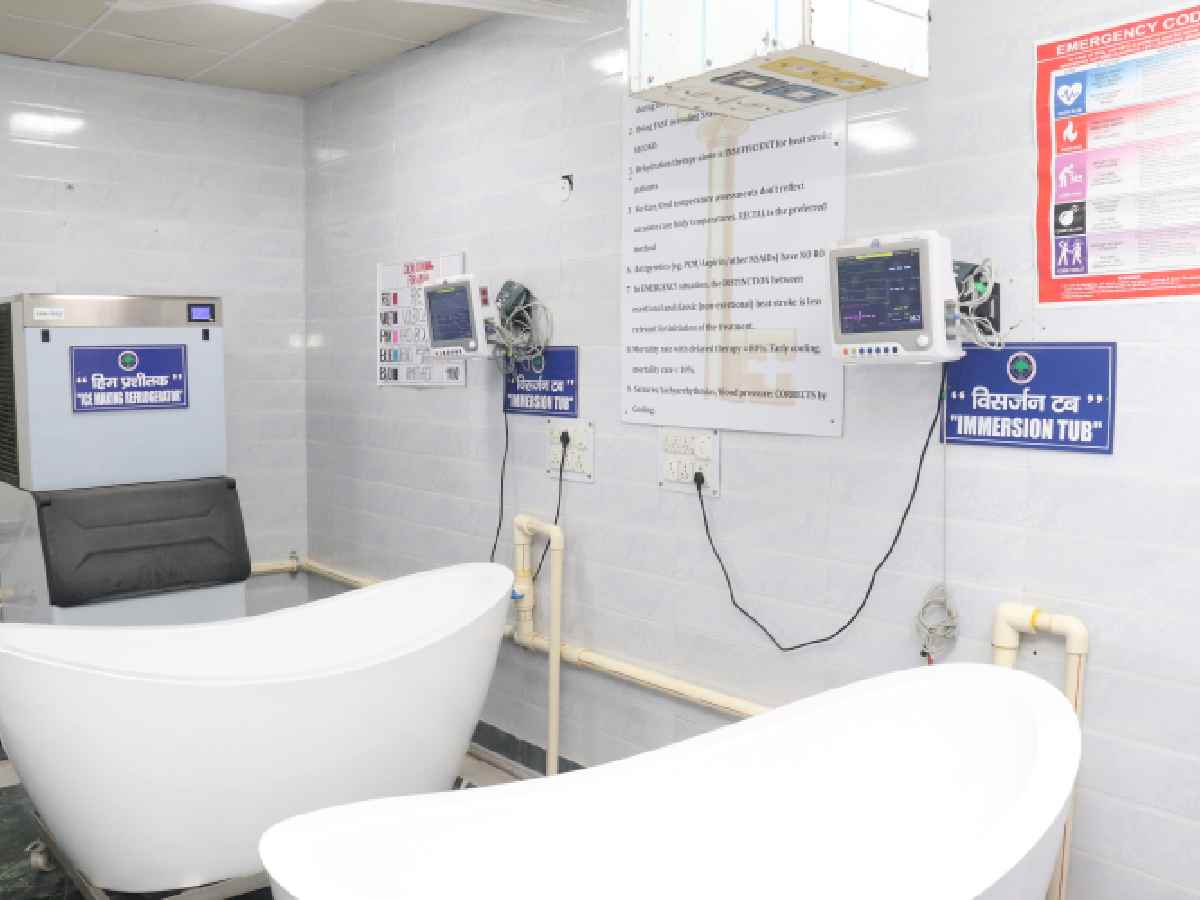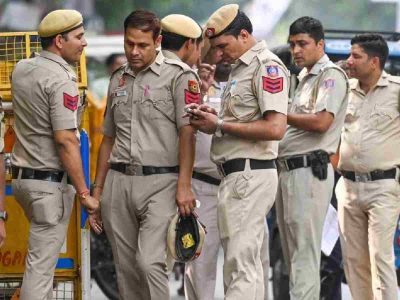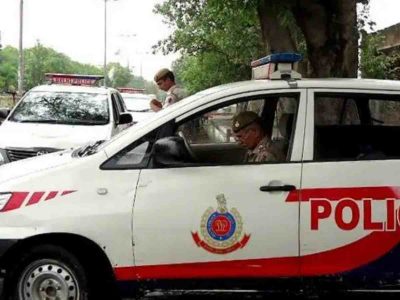As Delhi reels from the memory of one of the most severe and prolonged heatwaves in 2024, hospitals across the city are not only reflecting on their response to the crisis but are actively preparing for another challenging summer in 2025.
With temperatures repeatedly soaring past 42°C last year, prominent medical institutions such as the All India Institute of Medical Sciences (AIIMS) Delhi, Safdarjung Hospital, Ram Manohar Lohia (RML) Hospital, Lok Nayak Hospital (LNH), and Guru Teg Bahadur (GTB) Hospital had mobilised extensive emergency infrastructure—including heatstroke wards, helplines, and rapid response systems.
Now, these hospitals are building on that experience to scale up heat preparedness measures as the Capital braces for another punishing season.
Also read: Delhi: 20 forgotten monuments get a much-needed facelift
Dedicated heatstroke units and emergency protocols
In 2024, several hospitals operationalised separate heatstroke units equipped with centralised air-conditioning, ventilators, cooling equipment, and mobile heat vans. These units were designed to provide immediate and intensive care to those affected by extreme heat.
Among the most notable was the Centre-run RML Hospital, which reactivated its specialised heatstroke unit. The facility featured immersion cooling technology, critical care beds, and a Mobile Heat Stroke Response system to provide pre-hospital care.
RML also launched a dedicated helpline (011-23404446) for reporting suspected heatstroke cases, especially those found unconscious or gravely ill in public areas. “The service is designed to ensure timely medical intervention, especially in public spaces,” explained Dr Ajay Shukla, Medical Superintendent at RML. He warned that untreated heatstroke could carry a mortality rate as high as 80%, which could be reduced to around 10% with early intervention.
Dr Amlendu Yadav, Head of Emergency Medicine at RML, described heatstroke as a condition occurring when body temperature exceeds 105°F. “At this point, the body loses its natural ability to regulate heat through sweating, leading to unconsciousness or severe mental disorientation,” he said.
To counter this, the hospital employs an immersion cooling tub filled with nearly 50 kilograms of ice, maintained between 1°C and 3°C. Patients are submerged for approximately 25 minutes to rapidly reduce body temperature. RML also has its own ice manufacturing unit to ensure constant supply.
“Most patients we treat are outdoor workers like construction labourers and security guards who spend long hours in direct sunlight,” noted Dr Yadav. The specialised heatstroke unit, launched on May 8, 2024, has since become a cornerstone of Delhi’s heatwave response system.
Safdarjung Hospital’s upgraded 2025 preparedness
In anticipation of the 2025 summer, Safdarjung Hospital has conducted comprehensive sensitisation sessions and refresher training in March for its medical staff—including doctors, nurses, and paramedics. The focus of the training was on triage and the clinical management of heat-related illnesses (HRI), based on lessons learned from the 2024 crisis.
The hospital currently has six ventilator-equipped beds reserved for HRI patients, with the ability to scale up with six additional beds in Ward A and 50 more in the disaster ward. Cooling infrastructure such as large pedestal fans and coolers have been installed, while supplies including ice-lined refrigerators (ILRs), fluids, sheets, and ice packs have been stocked.
A senior doctor reported that informational, educational, and communication (IEC) materials are visibly displayed throughout the premises, and an alert notification system has been activated. A stakeholder meeting was held to ensure smooth resource mobilisation amid rising temperatures.
AIIMS Delhi takes decentralised approach
AIIMS Delhi, though lacking a dedicated heatstroke ward, is fully equipped with the necessary resources to manage heat-related illnesses. Due to its high patient load and wide range of medical cases, the hospital is following a decentralised approach.
A senior doctor stated that patients visiting the Outpatient Department (OPD) with symptoms of heat illness are being given proper diagnosis and care. “On the other hand, the hospital conducts public awareness lectures on the preventive measures from the heatwave,” he said.
“AIIMS is committed to ensure the best healthcare services are provided to the patients,” he added.
Lok Nayak and GTB hospitals maintain readiness
Lok Nayak Hospital is equipped with essential infrastructure, including cooling pads and centralised air-conditioning. The hospital has stocked up on fluids, cooling supplies, and medications. A senior official, speaking on condition of anonymity, noted that upgrades to the hospital’s heat preparedness plan are ongoing.
GTB Hospital has trained its healthcare personnel to manage heat-related emergencies. Its wards are air-conditioned and stocked with necessary supplies including cooling pads and essential medications. A senior doctor affirmed that GTB remains fully equipped to manage any surge in heatstroke cases.
Delhi government’s Heat Action Plan
To institutionalise the response, the Delhi government rolled out a comprehensive Heat Action Plan following the 2024 heatwave. The plan mandates all health facilities—from primary centres to tertiary hospitals—to report cases of heat illness and establish exclusive wards for heat-affected patients.
These wards are required to be set up in the coolest parts of hospital buildings and stocked with ORS packets, intravenous fluids, thermometers, blood pressure monitors, and air-conditioning units. Hospitals have also been asked to maintain supplies of drugs such as lorazepam and diazepam for acute symptoms, along with calamine lotion and silver sulphadiazine for skin issues caused by heat exposure.
Delhi’s ambulance network has also been upgraded. Ambulances are now equipped with ice packs and cold water for pre-hospital cooling during transport.
Rising toll of 2024 heatwave
The devastating impact of the 2024 heatwave is already part of the city’s health history. Delhi recorded 275 heat-related deaths, including 154 individuals who were brought dead to hospitals. These deaths reflect the acute danger extreme heat poses, especially to vulnerable populations.
The Centre for Holistic Development, an NGO, documented 192 deaths among homeless individuals between June 11 and 19, underlining the stark disparities in resilience across the population. Safdarjung Hospital alone admitted 84 patients with heatstroke symptoms since March 2024—64 of them in just five days. RML Hospital reported 11 deaths over a five-week span.
Crematoriums too saw a sharp rise in activity. Nigam Bodh Ghat, Delhi’s largest crematorium, recorded 142 cremations on June 19—the highest single-day figure since the COVID-19 pandemic.
National data reveals wider crisis
The problem is far from local. According to a report by the non-profit HeatWatch titled Struck by Heat: A News Analysis of Heatstroke Deaths in India in 2024, India witnessed 733 heatstroke deaths and more than 40,000 heat illness cases across 17 states between March and June 2024. This sharply contrasts with the Union Health Ministry’s official figure of 360 deaths, suggesting significant underreporting.
The report noted that 37 Indian cities crossed the 45°C mark, with many breaking historical temperature records. The data discrepancy points to systemic issues in reporting, preparedness, and responsiveness.
Also read: IIT Delhi students take ill, point to ‘poor’ hygiene at hostel mess
Private hospitals mirror public sector response
Aakash Hospital has taken proactive steps to address the heat threat in 2025, building on the model implemented by RML. Dr Shaarang Sachdev, Senior Consultant and Head – Emergency and Critical Care Medicine at Aakash Healthcare, said the hospital has set up dedicated heatstroke units.
“Drawing insights from the successful strategies employed by institutions like Ram Manohar Lohia Hospital, Aakash Hospital has established dedicated heatstroke units equipped with advanced facilities,” said Dr Sachdev.
“These units are furnished with ice-filled immersion tubs, high-capacity ice-making machines, and ventilator-equipped beds. Conscious or semi-conscious patients are immersed in ice baths, while surface cooling techniques are used for unconscious cases,” he added.
The hospital has allocated specific emergency beds for heatstroke cases and trained its staff in rapid identification and treatment. Supplies like ORS, intravenous fluids, and electrolyte solutions are well stocked.
“Recognising the importance of patient comfort and recovery, the hospital has enhanced its infrastructure with air coolers and consistent access to clean drinking water. Public awareness campaigns are also underway to promote hydration, proper clothing, and avoidance of peak sun exposure,” Dr Sachdev said.
At Fortis Escorts Hospital, similar preparations are ongoing. Dr Avi Kumar, Senior Consultant in Pulmonology, said the hospital is fully air-conditioned, properly ventilated, and fitted with hydration stations to protect both patients and staff during the heatwave season.





